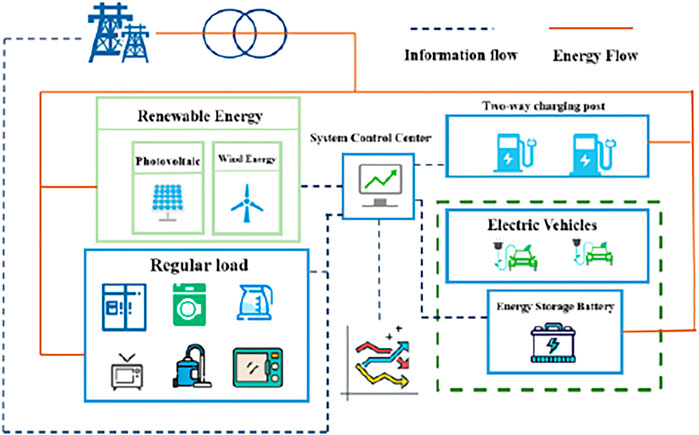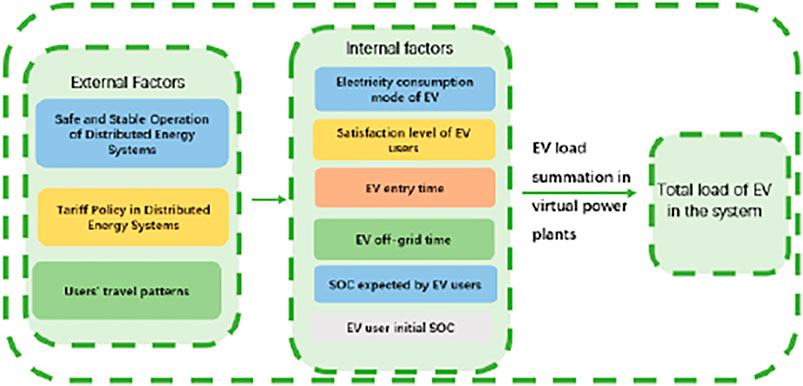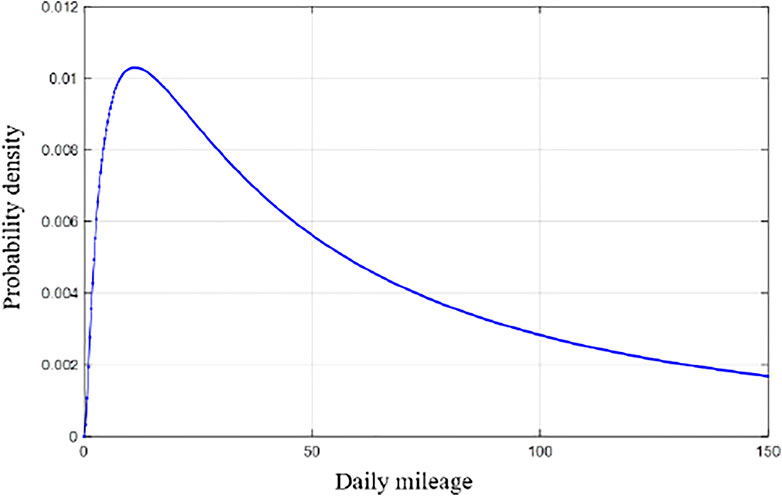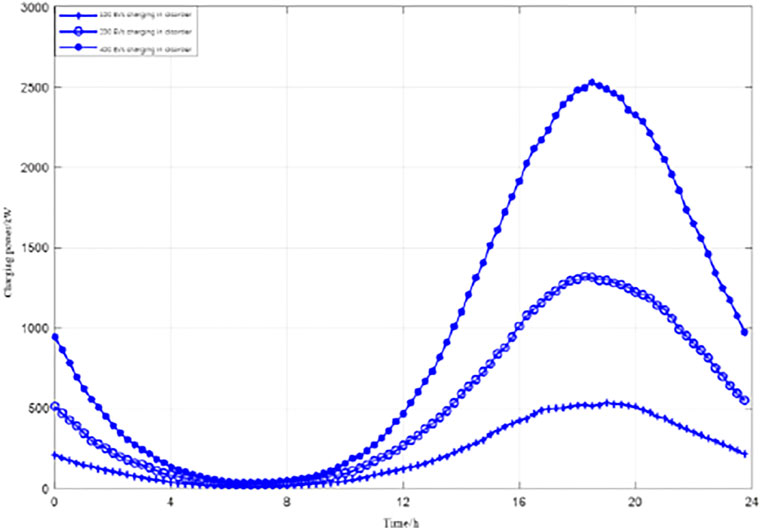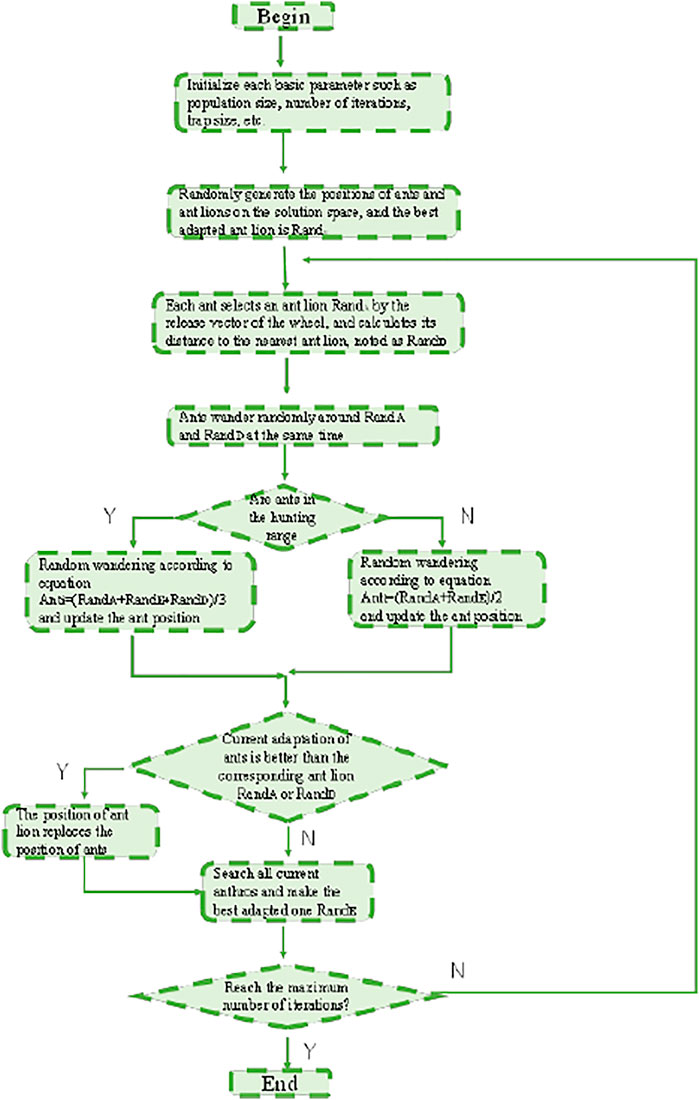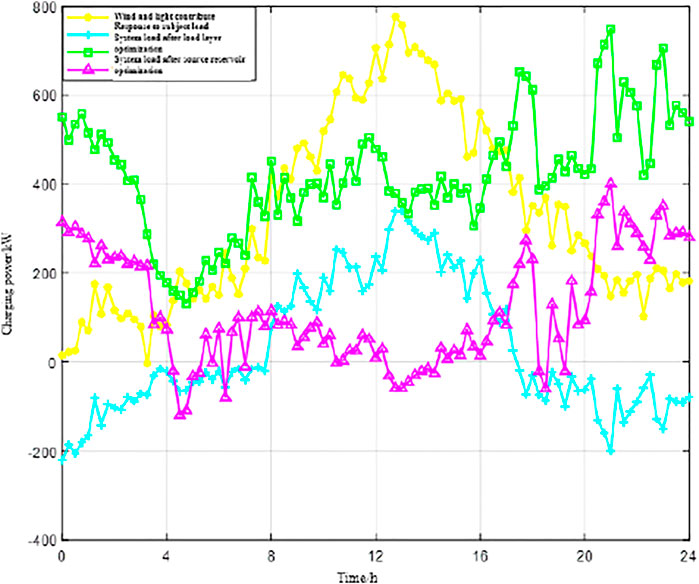- 1College of Automation Engineering, Shanghai University of Electric Power, Shanghai, China
- 2State Grid Ruian Electric Power Supply Company, Wenzhou, China
As environmental problems become more serious, the trend of “carbon peaking and carbon neutral” has become necessary. However, the disorderly entry of large-scale EVs into the grid has threatened the security of the grid. The purpose of this paper is to study the optimization strategy of EVs to improve the economy and stability of distributed energy. Firstly, the EV user behavior model is constructed to study the charging and discharging behavior influencing factors, and the EV charging and discharging loads are simulated using Monte Carlo simulation. Secondly, we build a hierarchical scheduling optimization strategy based on EV user satisfaction using an improved AntLion optimizer, finally, the load peaks of the distributed energy system are suppressed and the satisfaction of EV customers is significantly improved; in the process of EV scheduling optimization at the source storage layer, EVs fully consume renewable energy output and the comprehensive operating costs of the distributed energy system are reduced. The conclusions are verified and the system is optimized, resulting in improved user satisfaction and optimized system economy and stability.
Introduction
Energy plays a pivotal role in economic development. China’s energy structure is dominated by primary energy (Chen, 2021), along with a large number of carbon emissions that are extremely unfriendly to the environment. Therefore, the development of renewable energy is a necessary trend (Wu et al., 2020). However, due to the impact large-scale accessing of renewable energy from the grid will cause on the grid, the current frequent use of distributed energy in immediate consumption can solve the problem of large-scale decentralized access to the grid, and its promotion has significantly improved the utilization of energy. In summary, reasonable and optimal scheduling of EV charging and discharging loads can effectively improve the operation of distributed energy systems, and it is very important to study the problem of EV co-optimization based on economic and stability aspects (Wang et al., 2019).
Although EVs are developing vigorously everywhere, there is a lack of effective incentive mechanisms to guide EV users to charge and discharge in an orderly manner (Qilin and Qian, 2019). In addition, EVs have diversified charging needs, highway, residential buildings, and other places’ charging facilities utilization rate is very high, while third and fourth-tier cities have fewer charging facilities. At the same time, there are differences in the utilization rate of charging facilities due to the charging habits of different users. Therefore, EV charging and discharging should be guided by reasonable scheduling optimization strategies, so that public charging resources can be fully utilized while grid operation is minimized by EV charging and discharging to ensure safe and stable system operation (Hou et al., 2018; Zhao et al., 2021).
Modeling Analysis of EVs in Distributed Energy Systems
In this chapter, we construct the framework of the distributed energy system, the load capacity model of EV, and the influencing factors of EV charging and discharging load are also analyzed. These studies can provide strong support for the EV scheduling optimization strategy later in the paper.
EV Modeling Analysis
First of all, the framework of the distributed energy system is built, which includes a photovoltaic power generation system, wind turbine output system, and energy storage system (Wang et al., 2021). The framework of the distributed energy system is shown in Figure 1.
As a new network structure relative to the traditional grid, the distributed energy system contains RES, various types of customer loads, energy storage devices, a central control system, and a communication system. The framework of the grid-connected wind and storage distributed energy system established in this paper is shown in Figure 1. The roles of each module are shown as follows.
1) System control center (energy management center): an important unit for real-time control of the operation of the distributed energy system, using the information collected from the AMI as a basis to develop a reasonable optimization strategy for EV scheduling.
2) AMI (Intelligent Measurement System): is a multi-functional system that integrates the reading, sending, setting, and control of remote information by adopting different communication modes to transmit the measurement data from the user side back to the control center.
3) Bi-directional charging pile: the execution unit of EV energy conversion, which integrates charging and discharging functions and at the same time can record the charging and discharging power of EV and upload it to the system control center.
4) RES: renewable energy in the system, mainly refers to the wind and solar output units.
5) System response body: mainly refers to the energy storage lithium iron phosphate battery and EV power battery.
6) Internal tariff: In this study, internal tariff refers to a reasonable tariff mechanism.
The flexibility and randomness of EVs are shown in the parking time, travel moment, and driving range (Junhui et al., 2021).
EV Load Capacity Model
EVs can be used as both the demand and supply side in the grid, effectively guiding and controlling EVs in order to control orderly and reasonable charging. The factors affecting the load capacity of EVs are shown in Figure 2 (Zhang, 2020). EV charging and discharging load size is also affected by EV scale, and when large-scale EVs are charged and discharged in a disorderly manner, system operational reliability drops dramatically (Liting et al., 2020).
The total charge and discharge load of EV is
Where
User Behavior Modeling of EVs
The analysis of EV travel law is the basis for studying EV charging and discharging behavior. EV user behavior has uncertainty, so EV load distribution has randomness, mainly in the randomness of daily driving mileage.
Start Charging Moment
The main start charging time of private EVs is generally after coming home from work or on arriving at work, which is statistically strong, and the model generally obeys normal distribution, and its probability density function is
where
End Charging Moment
The start moment of the day trip obeys the normal distribution, and its probability density function is
where
The EV user’s use habit and daily driving range determine the remaining power at the moment the EV returns home.
The probability density function of the initial SOC of the EV is
The probability distribution of daily mileage for EVs is shown in Figure 3.
Modeling of EV User Satisfaction
The user satisfaction is divided into user’s travel.
(1) EV user travel satisfaction
where
(2) Cost satisfaction of EV users
where
The overall satisfaction of EV users can be expressed
Monte Carlo-Based Load Calculation for EVs
EV users’ charging and discharging behaviors are uncertain in both time and space, and factors such as origin, destination, and driving paths influence user behavior. In this section, the EV load is analyzed from a dual-scale perspective of time and space, and then the travel process of EV users in a day is calculated.
In this paper, the Monte Carlo method is used to simulate the load characteristics of EV clusters, and the specific method steps are shown below.
The Monte Carlo simulation method is different from the general method of calculating numerical values, it is a class of algorithms based on the theory of probability statistics. The problem for which a solution is required is sampled with random numbers, and the result will be infinitely close to the real solution after many repetitions of the sampling. The Monte Carlo simulation method is an excellent algorithm for events with high randomness that cannot be computed conditionally.
The Monte Carlo simulation method is based on the theoretical foundations of the “Theorem of Large Numbers” and “Central Limit Theorem”, which establish the reference for error evaluation in the Monte Carlo simulation method. The steps of the Monte Carlo simulation method are as follows (Wuzhi et al., 2020):
1) Determine the initial EV return time, off-grid time, power battery capacity, and the total number of EVs.
2) Calculating the initial SOC of EVs by extracting the daily mileage and arrival time of EVs based on the total number of EVs.
3) Calculate the charging period of EVs from the EV return time and daily driving mileage, and superimpose the load generated by each EV at each sampling moment to obtain the total load of EVs in this time period.
Using the Monte Carlo method to generate the EV driving in 1 day, the charging and discharging loads of 100 EVs were simulated and averaged according to the formula, and the specific results are shown in Figure 4. The curves from bottom to top simulate the generated loads when 100, 200, and 400 EVs are charged in an uncontrolled manner. As we can see in the figure, if EVs are allowed to charge without control, the charging time is concentrated in the evening from 18:00 to 23:00, because 18:00 is a more concentrated time for EV users to return home, and the charging peak is reached around 19:30 at night, and the original load of the distributed energy system is also at a peak at this time, resulting in the peak of the load level in the network. The original load of the distributed energy system is also at a peak at this time, leading to a peak on top of a peak in the load level in the network, bringing impact to the stable operation of the system, and the impact will increase step by step as the number of EVs increases.
Based on the power models of wind turbines, photovoltaic units, and energy storage systems, the load characteristics of EVs are analyzed and the curve of EV load in the system for a given day is obtained based on Monte Carlo’s computational analysis of EV load. It provides a basis for the collaborative energy optimization of EV participation in the distributed energy system later in the paper.
Optimization Strategy of EV Hierarchical Dispatching Based on User Satisfaction
Large-scale EVs connected to the distributed energy system can make the number of EVs accommodated by the original system increase significantly, and participation in the joint scheduling of the system is an inevitable future development trend.
Considering the comprehensive satisfaction of each EV user directly in the EV scheduling optimization process will make the problem extremely complicated and difficult to solve. Therefore, in this section, the scheduling optimization process of the distributed energy system is divided into load layer and source storage layer, and EVs with different characteristics are assigned to different layers, and their user satisfaction is considered for EVs in the load layer, and then the strategy is verified by simulating an actual scenario of the distributed energy system.
Hierarchical Scheduling Optimization Strategy
The EVs covered in this section are divided into two categories: EVs with a high degree of freedom and EVs that fully obey the management of the distributed energy system, and we only consider the user satisfaction of EVs with a high degree of freedom (Zhengfu et al., 2021).
The process of distributed energy system scheduling optimization is divided into two layers: the load layer, where EV user satisfaction is optimized while taking into account the original load peak; and the source storage layer, where further load optimization is performed on the system after optimization in the load layer (Shuai et al., 2022) so that EV load follows RES output and maximizes the absorption of RES output to reduce operating costs. The optimization strategy of hierarchical scheduling in the distributed energy system is shown in Figure 5 below.
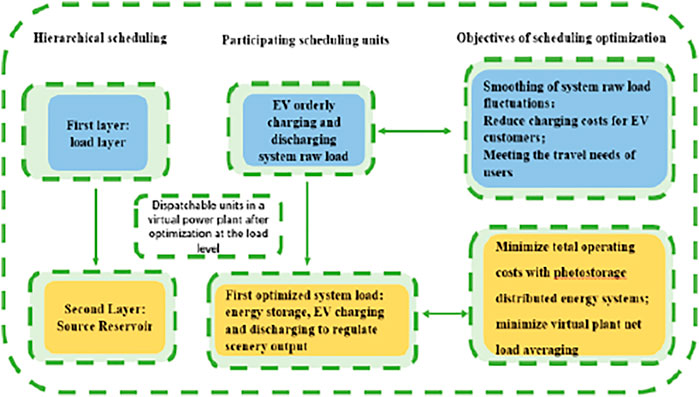
FIGURE 5. Tiered scheduling optimization strategy for distributed energy system considering customer satisfaction.
Load-Level Scheduling Optimization Strategy
Let the peak start moment of the original load LB (t) of the distributed energy system be Tstart and the peak end moment be Tend. The initial state of the EV at the time of grid entry depends on the entry moment
where q denotes the power consumption per kilometer driven by EVs;
In order to secure the next trip for EV users:
In order to increase the cost satisfaction of EV users, certain incentives are given to EV users for discharging.
Where
Source-Storage Level Scheduling Strategy
The main objective of the source-storage layer scheduling strategy is to reduce the operating cost of the distributed energy system while allowing the EV cluster to maximize the consumption of wind and light output so that the average value of the net load of the distributed energy system is minimized (Qinshuai et al., 2019).
where
EV Hierarchical Scheduling Optimization Strategy Solving and Result Analysis
Solution Method
Since the load-level scheduling optimization has the same logical framework as in Chapter 2, the optimization is performed using the Monte Carlo method, which is used to simulate the wind turbine, PV output, and EV load for the load tier scheduling optimization strategy (Yuying et al., 2021).
In solving the multi-objective multi-constraint optimization model for source storage layer scheduling the multi-objective optimization problem is transformed into a single-objective optimization problem using the linear weighting method.
where
The model is then solved using the improved AntLion Optimizer.
In the case of uneven illumination, uncontrollable human factors, and a complex detection environment, the results predicted by the algorithm calculation performed by the general algorithm may have problems such as inaccurate data evaluation. In this case, it is necessary to improve the accuracy of the operation to achieve accurate prediction. For the hyperparameter optimization problem, Grid Search is too computationally intensive; the Bayesian optimization technique requires a priori sample design, difficult kernel function selection, and long evaluation time, and EV scheduling optimization needs a lot of data support, so AntLion Optimizer is finally decided.
The algorithm steps are shown in Figure 6.
The methodological framework is useful for policymakers to improve the appropriate charging strategy to achieve an optimal balance between charging and discharging in the face of a large number of EVs charging in a disorderly manner.
Algorithm Parameter Settings
In this section, to re-simulate a specific distributed energy system scenario, the system contains wind turbines, photovoltaic units, a lithium iron phosphate battery storage system, and a certain scale of private car EVs; the system contains a 400kW photovoltaic battery and 400 kW of wind turbines, plus the capacity of 300 kW lithium iron phosphate as energy storage units, electrochemical energy storage losses converted to The cost is
The proposed model is programmed, analyzed and its simulation results are calculated in MATLAB R2018a.
Analysis of the Results
(1) Results of the load level optimization
According to the management strategy for EVs, the peak load of the distributed energy system can be reduced, and the obtained results are shown in Figure 7.
As seen in Figure 7 A large number of EVs return to the distributed energy system one after another after 17:00 but do not charge directly, while the main charging period is concentrated between 22:00 on the first day and 4:00 on the second day, charging until the SOC automatically quit charging and maintained a static state. The average net load value changed from 170.4769 to 147.1115 kW, the load-level scheduling strategy played a role in suppressing load peaks and increasing the operational stability and reliability of the system.
The EV users who participate in peak discharge will get the incentive fee, and according to Eq. (18), the comprehensive satisfaction of EV users before and after the optimization of the distributed energy system in the scheduling optimization process of the load layer is 0.38 and 0.79, respectively. Its value is significantly improved. The details are shown in Table 1.
(2) Results of source reservoir optimization
The daily total load optimization results of the load layer are substituted into the optimization model of the source reservoir, and the model is solved by using the improved ALO algorithm (Qiu et al., 2021), and the output of each dispatchable unit of the source reservoir is shown in Figure 8.
The response curve is shown as the cyan curve in Figure 8, and the trend of the response curve is almost the same as the trend of the background output curve. In addition, the graph shows that the response body starts charging when the background output is at a high level (i.e., from 8:00 a.m. to 16:00 p.m.), and stays mostly discharged for the rest of the time.
In the scheduling optimization of the source storage layer, all EVs have the substitution role of energy storage units, so the power fluctuation of energy storage units is relatively small.
(3) Comparative analysis
The simulation indexes (including cost, net load average, and EV user satisfaction) in the case of EV unordered charging are compared and analyzed with the indexes of EV stratified ordered charging and discharging, and the details are shown in Table 2.

TABLE 2. Comparison of the results of disordered charging and hierarchically ordered charging and discharging of EVs.
Integrating the load level optimization and source reservoir optimization experimental data, the data in the following table contains the hierarchical ordered charging and discharging of EVs for two different scenarios.
As seen in Table 2, from the operator’s point of view, the hierarchical ordered charging and discharging strategy relative to disordered charging has more EV discharging incentives for this expenditure, but even though the cost of the distributed energy system increases by one, the final total system operating cost decreases by $919 and gets optimized, while the average net load in the system decreases by 57% and the satisfaction of EV users increases by 107%.
The proposed hierarchical scheduling optimization strategy considering EV user satisfaction has a good effect on improving the economy and stability of distributed energy system operation (Ye et al., 2021). From the results of the analysis of the calculation cases, it can be seen that in the process of EV dispatch optimization in the load layer, the net load mean value of the distributed energy system is effectively reduced, and the satisfaction of EV users is significantly improved, which realizes the sustainability of the economic dispatch optimization strategy of the distributed energy system proposed in this paper; in the process of EV dispatch optimization in the source storage layer, the EV load fully consumes the renewable energy. In the process of EV scheduling optimization at the source storage layer, the EV load fully consumes the renewable energy output and the storage output is less, which makes the comprehensive operation cost of the distributed energy system reduced, thus forming a win-win situation for all parties in a real sense.
Conclusion
As EVs enter the network on a large scale, they are facing two problems: how to make large-scale EVs enter the network in an orderly manner and optimize the scheduling strategy to achieve better results, and how to set the charging facilities and charging mode to make the highest utilization rate. In this paper, we analyze the charging and discharging behavior of EV users in a distributed energy system scenario, and use time-of-use tariffs to guide EV users, so as to solve the problem of large-scale EVs entering the grid in an orderly manner and improve the RES utilization rate and achieve peak and valley reduction effects.
For the first problem, in the distributed energy system, we analyze EV users’ charging and discharging behavior, use time-of-use tariffs to guide EV users solve the problem of large-scale EVs entering the grid in a disorderly manner, improve RES utilization, and achieve peak and valley reduction effects.
For the second problem, we establish a Monte Carlo simulation-based EV disorderly charging model to verify that large-scale EV disorderly access will add peaks to the system load, seriously threatening the reliability and stability of system operation; a hierarchical scheduling optimization model based on EV user satisfaction is developed and solved; a hierarchical scheduling optimization strategy for distributed energy systems considering EV customer satisfaction is proposed. From the results of the analysis of the calculation case, it can be seen that in the process of load-level EV dispatch optimization, the load peak is suppressed, customer satisfaction is greatly improved, and the sustainable development of the economic dispatch optimization strategy for distributed energy systems is realized; in the process of EV scheduling optimization at the source storage layer, EVs fully consume renewable energy output and the comprehensive operating costs of distributed energy systems are reduced, thus forming a mutually beneficial win-win situation for multiple parties in a real sense.
With the development of Internet technology and the continuous iteration and upgrading of the semiconductor industry, there is no big problem in software and hardware, then the key of the problem becomes how to arrange a scheduling optimization strategy for EVs to achieve better results, and this paper carries out scheduling optimization to solve the problem.
With the influence of national policies in recent years, the popularity of EVs in China has been quite high, and the rapid development of EVs in China is staggering. However, the real situation is that EVs in China are only promoted and used in areas such as Beijing Shanghai, and Guangzhou, and the popularity of EVs in third and fourth-tier cities and towns is still very limited, and the construction of public charging facilities in cities is relatively small, which is not enough to support the free use of EVs by EV users. But the times are progressing, and we hope that our country will have its own core competitiveness in both EV and semiconductor-related technologies. In the future, the rapid development of artificial intelligence will also make the two problems raised in the previous article no longer exist, and all the scheduling strategies and charging and discharging behaviors will be executed very intelligently and efficiently, while our power workers may also face more technical challenges, so it will be a great test for us all.
Data Availability Statement
The original contributions presented in the study are included in the article/Supplementary Material, further inquiries can be directed to the corresponding author.
Author Contributions
CL, DP, HZ, and SY contributed to conception and design of the study. CL EF the first draft of the manuscript. DP, HZ, and SY wrote sections of the manuscript. All authors contributed to manuscript revision, read, and approved the submitted version.
Funding
This work is supported by the National Natural Science Foundation of China (No. 92067105, No. 71871160, No. 52006131), Shanghai Science and Technology Commission Program (No. 20020500500), Shanghai Sailing Program (No. 20YF1414900), Engineering. Research Center of Shanghai Science and Technology Commission Program (No. 14DZ2251100), “Chen Guang” project supported by Shanghai Municipal Education Commission and Shanghai Education Development Foundation (No. 20CG61).
Conflict of Interest
SY was employed by State Grid Ruian Electric Power Supply Company.
The remaining authors declare that the research was conducted in the absence of any commercial or financial relationships that could be construed as a potential conflict of interest.
Publisher’s Note
All claims expressed in this article are solely those of the authors and do not necessarily represent those of their affiliated organizations, or those of the publisher, the editors and the reviewers. Any product that may be evaluated in this article, or claim that may be made by its manufacturer, is not guaranteed or endorsed by the publisher.
References
Chen, X. (2021). Application of Load Forecasting in Distributed Energy Systems. Electron. Technol. Softw. Eng. 21, 209–212.
Hou, J., Lin, Z., Yang, L., Yi, D., KaiNing, L., Bin, Y., et al. (2018). Optimal Design of Power Packages for Commercial and Industrial Customers for Demand-Side Active Response. Power Syst. Automation 42 (24), 11–19. doi:10.7500/AEPS20180404002
Junhui, L., Hongkun, B., Yufeng, W., Hujun, L., and Qinchen, Y. (2021). “Research on Demand Response Characteristics of Electric Power Consumers Based on Monte Carlo Simulation,” in Proceedings of the 2021 IEEE International Conference on Power Electronics, Computer Applications (ICPECA), Shenyang, China, January 2021, 58–64. Henan Electrical Engineering Society 2021 Outstanding Scientific and Technical Papers. doi:10.26914/c.cnkihy.2021.036893
Junliu, Z., Wei, F., Zhongfu, T., Liwei, J., gejiriv, D., Xinbo, Y., et al. (2020). A Multi-Objective Scheduling Optimization Model for Interconnected Gas and Electricity Virtual Power Plants with Demand Response. Power Construction 41 (02), 1–10. doi:10.3969/j.issn.1000-7229.2020.02.001
Liting, T., Lin, C., Jianbo, G., Xuanyuan, W., Chen, Y. Q., and Wenzhong, G. (2020). A Review of Research on the Management and Interaction Mechanism of Virtual Power Plants for Distributed Energy Sources. Power Grid Technol. 44 (06), 2097–2108. doi:10.13335/j.1000-3673.pst.2019.2193
Qilin, H., and Qian, A. (2019). Electricity Market Bidding Strategy for Virtual Power Plants Containing Demand Response in a Power Sales Side Liberalization Environment. Power Construction 40 (02), 1–10. doi:10.3969/j.issn.1000-7229.2019.02.001
Qinshuai, X., Qing, H., and Kangyuan, W. (2019). Improved Ant- Lion Algorithm for Wireless Sensor Network Coverage Optimization. J. Sensing Technol. 32 (02), 266–275.
Qiu, C.-M., Qu, D., Fan, J.-H., Liu, Q.-Y., Liu, X., and Tang, Q.-Q. (2021). Optimal Control of Distribution Network Energy Based on the Participation of Electric Vehicle Aggregators in Demand Response Business. Electr. Mech. Eng. Technol. 50 (05), 72–75.
Sheng, Z., and Jiayan, L. (2021). Path Planning of Warehouse Robot Based on Improved Ant-Lion Algorithm. Combined Machine Tools Automated Machining Technol., 32–36. doi:10.13462/j.cnki.mmtamt.2021.12.008
Shuai, H., Ping, S. L., Bin, L. J., and Xuan, G. X. (2022). A Multi-Objective Optimal Scheduling Strategy for Inter-area Virtual Power Plant with Gas-Electric Interconnection Containing Electric Vehicles. Energ. Storage Sci. Technol., 1–9. doi:10.19799/j.cnki.2095-4239.2021.0611
Su, H. S., and Dong, X. Y. (2021). Probabilistic Tide Calculation for Power Systems Containing Wind Power Based on Improved Stochastic Response Surface Method. J. Solar Energ. 42 (06), 289–296. doi:10.19912/j.0254-0096.tynxb.2019-0191
Wang, G., Song, Y. H., Huang, B., Cai, H., and Gao, C. W. (2021). Research on Residential Customers' Time-Of-Use Tariff Pricing Strategy Based on Non-complete Information Stackelberg Game. Electricity Supply and Consumption 38 (2), 46–52. doi:10.3969/j.issn.1004-1699.2020.04.010
Wang, X.-Y., Liu, D.-N., Liu, N., Liu, M.-G., Wang, J.-N., Gao, Y., et al. (2019). Virtual Power Plant Operation Mechanism and Key Technologies under Ubiquitous Power IoT. Power Grid Technol. 43 (09), 3175–3183. doi:10.13335/j.1000-3673.pst.2019.1185
Wu, Y., Gao, J., Hong, Y., Zhou, H., Ye, J., and Liu, L. (2020). “Regulation Model of Suppressing Wind Power Fluctuation Based on Small Hydropower Virtual Power Plant,” in Proceedings of the 2020 International Conference on Green Energy, Environment and Sustainable Development, China, August 2020, 27–34. doi:10.26914/c.cnkihy.2020.033563
Wuzhi, Z., Siyu, H., Yang, C., Kai, X. G., and Yuting, Z. (2020). Coordinated Optimal Scheduling of Wind- Power-Photothermal-Carbon Capture Virtual Power Plants Considering Source-Load Uncertainty. Power Grid Technol. 44 (09), 3424–3432. doi:10.13335/j.1000-3673.pst.2019.1986
Yaosong, X., Yanqiang, D., Yuhong, W., and Nai-Wai, T. (2020). Short-term Load Forecasting Based on Similar Day Selection with Improved Stacking Integrated Learning. J. Sensing Technol. 33 (04), 537–545. doi:10.7500/AEPS20180731009
Yapeng, Z., Yunfei, M., Hongjie, J., Mingshen, W., Yu, Z., and Zheng, X. (2019). A Multi-Timescale Responsiveness Assessment Model for Electric Vehicle Virtual Power Plants. Power Syst. Automation 43 (12), 94–103.
Ye, S. Y., Wei, J., Ruan, H. B., Liu, J. Y., Liu, X. N., and Gao, H. J. (2021). Robust Power purchase and Sale Strategy for Virtual Power Plant Distribution under Deep Interaction of Diverse and Flexible Loads. Power Construction 42 (01), 59–66.
Yuying, S., Peng, P., Guiru, C., and Bing, W. (2021). Spatial Load Prediction of Spatial and Temporal Distribution of Electric Vehicle Charging Load[J]. Comput. Digital Eng. 49 (10), 2139–2144. doi:10.3969/j.issn.1000-7229.2020.02.001
Zhang, W. (2020). Research on Generalized Predictive Control Based on Improved Ant-Lion Algorithm for T-S Fuzzy Model. Mod. Comput. (01), 12–15. doi:10.3969/j.issn.1007-290X.2021.005.007
Zhao, M. Z., Liu, Y. L., and Zhang, G. Q. (2021). Multi-objective Optimization of Distributed Energy Supply Network Based on Energy Interconnection[J]. Power Technol. Environ. Prot. 37, 40–50. doi:10.19944/j.eptep.1674-8069.2021.06.006
Keywords: simulation EV user behavior, scheduling optimization, user satisfaction, Monte Carlo, antlion optimizer
Citation: Peng D, Li C, Zhao H and Yin S (2022) Research on EV Scheduling Optimization Strategy Based on Monte Carlo and AntLion Optimizer. Front. Energy Res. 10:855679. doi: 10.3389/fenrg.2022.855679
Received: 15 January 2022; Accepted: 22 February 2022;
Published: 26 April 2022.
Edited by:
Zhile Yang, Shenzhen Institutes of Advanced Technology (CAS), ChinaReviewed by:
Jianhua Zhang, North China Electric Power University, ChinaNikolaos Koltsaklis, Czech Technical University in Prague, Czechia
Li Jia, Shanghai University, China
Copyright © 2022 Peng, Li, Zhao and Yin. This is an open-access article distributed under the terms of the Creative Commons Attribution License (CC BY). The use, distribution or reproduction in other forums is permitted, provided the original author(s) and the copyright owner(s) are credited and that the original publication in this journal is cited, in accordance with accepted academic practice. No use, distribution or reproduction is permitted which does not comply with these terms.
*Correspondence: Huirong Zhao, bGljaGVueGkxMjI5QDE2My5jb20=
 Daogang Peng1
Daogang Peng1 Chenxi Li
Chenxi Li